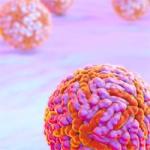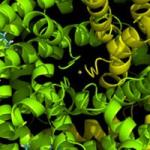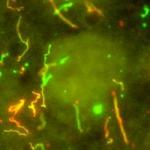
Research Topics
Ribonucleic acids (RNA) are remarkable molecules. In addition to serving their classical role as carriers of genetic information, they are also cellular machines that perform enzymatic and regulatory functions previously only ascribed to proteins. Furthermore, since RNA molecules are simultaneously capable of carrying genetic information and functioning as catalysts, they can be subjected to evolutionary selection pressures and may have formed the basis for ancestral life. Finally, RNA’s central role in life suggests that its potential therapeutic value is barely tapped but already clinically validated: approximately 80 percent of antibiotics in use today target a single type of RNA-containing enzyme, the ribosome, and most do so by targeting its non-coding RNA component.
Dr. Ferré-D’Amaré studies RNA molecules in their many guises. His laboratory develops and exploits fundamental biophysical approaches to understanding the function of ribozymes (catalytic RNAs) and the interactions between RNA and proteins at the level of atomic structure. Dr. Ferré-D’Amaré is also interested in the role of RNA molecules in gene regulation and signal transduction (e.g., riboswitches, non-coding mRNA domains that directly bind to specific small molecules or macromolecules and control transcription, translation, or splicing). He and his colleagues focus on the way RNA molecules fold into three-dimensional structures and how they are modified post-transcriptionally, and use this information rationally to design new molecular tools. Finally, he uses the dual function of RNA molecules as information carriers and catalytic agents to artificially evolve them, study their properties, and engineer them.
Among his varied research interests, Dr. Ferré-D’Amaré has several programs with strong translational implications. The first is a discovery initiative for small molecule antibiotic leads that bind to riboswitches. Riboswitches have been largely ignored as targets for drug discovery, yet their central role is clear in clinically important phenomena such as bacterial biofilm formation. Biofilms are assemblages of bacteria that adhere to biological and non-biological substrates and resist existing treatment. Their formation is regulated by cyclic-di-GMP-sensing riboswitches. Dr. Ferré-D’Amaré's laboratory has identified many compounds that bind specifically to bacterial riboswitches. He is currently developing these leads into more potent molecules, in collaboration with colleagues at Cambridge University, NCATS and NCI. Unlike mammalian cells, bacteria and yeast have rigid cell walls that form a protective exoskeleton. Dr. Ferré-D’Amaré’s second translational research focus is on the role of a catalytic RNA—glmS—in controlling the synthesis of the bacterial cell wall. GlmS operates not only as a catalytic RNA but also as a riboswitch and controls cell wall biosynthesis. By determining its crystal structures in multiple functional states, Dr. Ferré-D’Amaré's laboratory has generated "molecular movies" of the glmS ribozyme in action. These studies have revealed how the glmS ribozyme can employ a small molecule as a coenzyme. The glmS ribozyme is being studied as a potentially valuable target for novel antibiotics, and also an experimental platform with which to understand how RNA targets can evolve antibiotic resistance. Finally, Dr. Ferré-D’Amaré's interest in non-coding RNA biology has led him to structural and molecular engineering studies of fluorescent RNAs. Much like green fluorescent protein (GFP) and its variants transformed the study of proteins, fluorescent RNAs have the potential to revolutionize the in vivo study of the tens of thousands of non-coding RNAs that have been discovered in the human transcriptome. Dr. Ferré-D’Amaré and colleagues elucidated the structural basis for fluorescence of several RNA-chromophore complexes, and are leveraging this knowledge to generate optimized tools to study the synthesis, maturation, targeting, localization and turnover of RNAs that play essential roles in metabolism, development and disease progression.
Biography
Adrian R. Ferré-D'Amaré graduated from the Instituto Tecnológico y de Estudios Superiores de Monterrey in Mexico in 1990 with a B.S. in chemistry. He earned a Ph.D. in molecular biophysics from The Rockefeller University in 1995. He was a Jane Coffin Childs postdoctoral fellow at Yale University from 1995 to 1999. Dr. Ferré-D'Amaré was a Member of the Fred Hutchinson Cancer Research Center and an Affiliate Professor of Biochemistry at the University of Washington, Seattle, from 1999 to 2011. He was also an Investigator of the Howard Hughes Medical Institute (HHMI) from 2008 to 2011. He resigned from HHMI and joined the NHLBI in 2011 as a Senior Investigator and Chief of the Laboratory of RNA Biophysics and Cellular Physiology. Dr. Ferré-D'Amaré was a Rita Allen Foundation Scholar from 2001 to 2004, received the Eli Lilly and Company Research Award from the American Society for Microbiology in 2004 and was a Distinguished Young Scholar in Medical Research of the W.M. Keck Foundation from 2003 to 2008. Dr. Ferré-D'Amaré has authored or coauthored more than 100 papers. He is on the editorial board of the journal RNA and has served on many review panels for the National Institutes of Health, the National Science Foundation, as well as foreign and international scientific organizations.
Selected Publications
- Trachman RJ 3rd, Passalacqua LFM, Ferré-D'Amaré AR. The bacterial yjdF riboswitch regulates translation through its tRNA-like fold. J Biol Chem. 2022;298(6):101934.
- Passalacqua LFM, Banco MT, Moon JD, Li X, Jaffrey SR, Ferré-D'Amaré AR. Intricate 3D architecture of a DNA mimic of GFP. Nature. 2023;618(7967):1078-1084.
- Jones CP, Ferré-D'Amaré AR. Crystal structure of the severe acute respiratory syndrome coronavirus 2 (SARS-CoV-2) frameshifting pseudoknot. RNA. 2022;28(2):239-249.
- Warner KD, Chen MC, Song W, Strack RL, Thorn A, Jaffrey SR, Ferré-D'Amaré AR. Structural basis for activity of highly efficient RNA mimics of green fluorescent protein. Nat Struct Mol Biol. 2014;21(8):658-63.
- Zhang J, Ferré-D'Amaré AR. Co-crystal structure of a T-box riboswitch stem I domain in complex with its cognate tRNA. Nature. 2013;500(7462):363-6.
Related Scientific Focus Areas




Molecular Biology and Biochemistry
View additional Principal Investigators in Molecular Biology and Biochemistry

Microbiology and Infectious Diseases
View additional Principal Investigators in Microbiology and Infectious Diseases
This page was last updated on Thursday, August 28, 2025